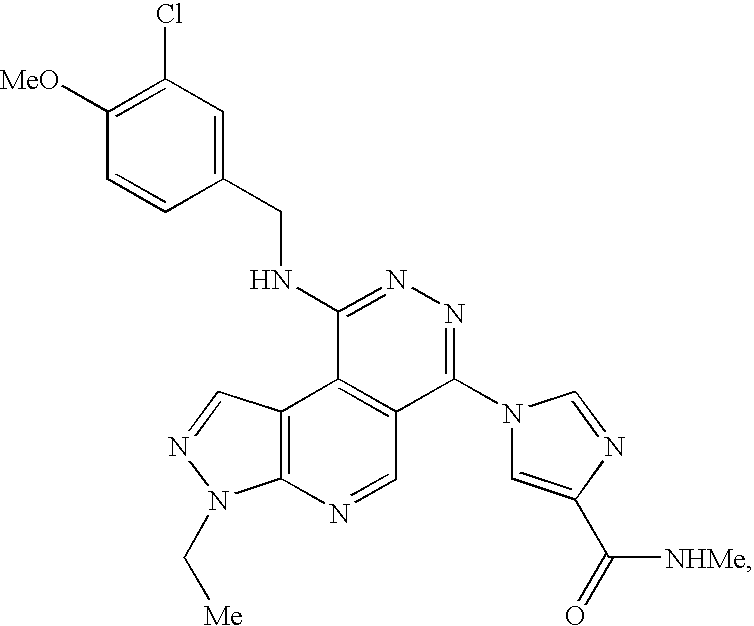Treatments of b-cell proliferative disorders
a proliferative disorder and b-cell technology, applied in the field of treatment of b-cell proliferative disorders, can solve the problems of mm remaining incurable disease and patients eventually succumbing to cancer, and achieve the effect of reducing the agonist-induced antiproliferative
- Summary
- Abstract
- Description
- Claims
- Application Information
AI Technical Summary
Benefits of technology
Problems solved by technology
Method used
Image
Examples
example 1
[0060]Materials and Methods
[0061]Tumor Cell Culture
[0062]The MM.1S, MM.1R, H929, RPMI-8226, MOLP-8, OPM2, EJM, ANBL-6, and KSM-12-PE multiple myeloma cell lines, the Burkitt's lymphoma cell line GA-10, non-Hodgkin's lymphoma cell lines Farage, SU-DHL6, Karpas 422, Pfieffer, and Toledo, the Kusami-1 AML cell line, and the mantle cell lymphoma cell lines Mino and JVM-13 were cultured at 37° C. and 5% CO2. All of the cell lines were cultured in RPMI-1640 media supplemented with 10% FBS except OCI Ly10 cells (IMDM media supplemented with 20% human serum). The ANBL-6 cell line culture media also contained 10 ng / ml IL-6. MM.1S, MM.1R, SU-DHL6, Karpas 422, and OCI ly10 cells were provided by the Dana Farber Cancer Institute. ANBL-6 cells were provided by Bob Orlowsli (M.D. Anderson Cancer Research Center). H929, RPMI-8226, GA-10, Farage, Mino, JVM-13, Pfeiffer, Toledo, and Kusami-1 cells were from ATCC (Cat #'s CCL-155, CRL-9068, CRL-2392 CRL-2630, CRL-3000, CRL-3003, CRL-2632, CRL-2631, a...
example 2
[0072]The RPMI-8226, MM.1S, MM.1R, and H929 mM cell lines were used to examine the activity of various compounds. The synergy scores obtained are provided in the Tables 7-15.
TABLE 7Summary of synergy scores for adenosine receptor agonists andphosphodiesterase inhibitors that synergize with dexamethasone inone or more mm cell line (RPMI-8226, MM.1S and H929)Cell Line:RPMI-Compound8226H929MM.1SADAC5.087.086.98Papaverine3.493.052.99Trequinsin5.762.683.21(S)-ENBA8.647.827.30BAY 60-75501.370.8221.44R-(−)-Rolipram1.720.5450.371Rolipram1.430.09270.203CCPA5.04n.d.5.15Chloro-IB-MECA5.615.298.37HE-NECA17.77.628.94Cilostamide1.420.9821.34EHNA1.14n.d.n.d.CGS-216802.54n.d.4.73
[0073]Data obtained for some of the 6×6 dexamethasone combination crosses is displayed below. Inhibition of proliferation was measured as described above after incubation of cells with test compound(s) for 72 hours. The effects of various concentrations of single agents or drugs in combination were compared to control wells...
example 3
Identification of Non-Steroidal Synergistic Antiproliferative Combinations with A2A Receptors Agonists
[0074]Compounds that synergize with glucocorticoids (glucocorticoid enhancers) to inhibit proliferation define proteins / pathways of importance for multiple myeloma growth and survival. As a result, these enhancers represent a starting point for the identification of new, novel non-steroid containing drug combinations for MM treatment. Combination activity may be observed when these non-steroid compounds are co-administered together or with other agents. To test this hypothesis, we used cHTS to screen the adenosine receptor agonists with a 151 compound library set, to identify steroid-independent synergistic antiproliferative activities.
[0075]The adenosine receptor agonists, which include ADAC, HE-NECA, and chloro-IB-MECA were the most active of the glucocorticoid enhancers when screening the 151 compound library set. Below is a summary of the list of agents that synergized with the ...
PUM
| Property | Measurement | Unit |
|---|---|---|
| compositions | aaaaa | aaaaa |
| concentration | aaaaa | aaaaa |
| B-cell proliferative disorder | aaaaa | aaaaa |
Abstract
Description
Claims
Application Information
 Login to View More
Login to View More - R&D
- Intellectual Property
- Life Sciences
- Materials
- Tech Scout
- Unparalleled Data Quality
- Higher Quality Content
- 60% Fewer Hallucinations
Browse by: Latest US Patents, China's latest patents, Technical Efficacy Thesaurus, Application Domain, Technology Topic, Popular Technical Reports.
© 2025 PatSnap. All rights reserved.Legal|Privacy policy|Modern Slavery Act Transparency Statement|Sitemap|About US| Contact US: help@patsnap.com

